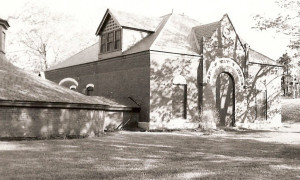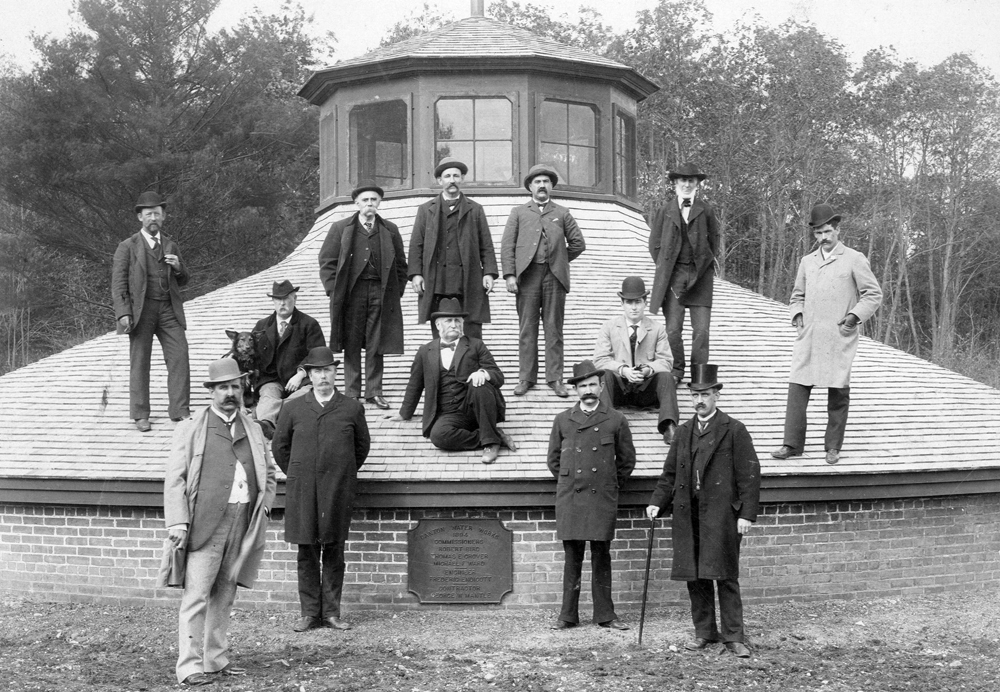True Tales from Canton’s Past: The Water Works
By George T. ComeauIt was one of the largest town meetings in anyone’s memory. Hundreds of men packed Memorial Hall in April 1884. The topic at hand was the establishment of a committee that would investigate the sources of water supply available to the town. The discussion had begun as early as 1882, and now the town was prepared to “study” the issue. The committee turned to William Wheeler, a prominent hydraulic engineer from Boston. The following year Wheeler issued a report that studied the potential sources of a robust water supply that could serve our town with sources from Sharon, Stoughton, and within Canton itself.
By 1885, the town was given permission through the Canton Water Act to fund the project with the issuance of $150,000 worth of credit for bonds. A full commission was appointed in August 1887. The proposed system would change over the next several years, but some of the basic elements would stay intact. More than 14 miles of pipe were called for in the initial plan, and standpipes would be constructed on high ground to allow sufficient pressure to feed hydrants and low-lying areas. The driving impetus was for fire protection, but several other uses were contemplated at the same time. The report that was issued a year after the vote to investigate a system stated, “The revenue from the works constructed as proposed would possibly at once, and almost certainly within a very few years, be sufficient to pay the interest upon the debt incurred, the cost of maintenance of the works, and necessary per centage towards a sinking fund.” This would not be the case.
At the heart of the water plan was the fact that the town had been growing at a rate of more than 20 percent every decade for more than 60 years. The growth meant that in 1840 there were less than 2,000 people living in Canton, which grew to more than 4,500 in 1880. The water needs for a burgeoning town in the year 1884 was estimated to be over 200,000 gallons per day. The Board of Health had been projecting dire consequences if a system for introducing clean water instead of private wells was not put in use. “The close proximity to privies and cesspools … formed a nidus for the reception of contagious miasmata, which is liable at anytime to bring upon our people epidemic diseases.”
By 1887, the first of the town’s water pipes were being installed as the system began to take shape. By 1889 the water commissioner reported that the works were still in an unfinished condition. That being said, water began flowing in May of that same year. As in many public works projects, the costs had begun to creep well beyond the estimates. Fourteen miles of pipe had been laid, and a 65-foot standpipe had been built. At the heart of the system was the splendid new brick pumping station at Springdale.
Springdale was, as the name suggests, the site of a well-defined aquifer of water that sprang from York Brook, then crossed into Pleasant Street and down into Pine Street from Beaver Brook. The site was chosen because it sat relatively near the brook and wetland and downstream enough that sufficient water could flow to the pumping station and into the holding well. In addition, the building was close to the Stoughton line and near Henry Springs, a second station that collected water for the town system. The filter well was 40 feet in diameter and more than 25 feet deep. Finally, the main well was part of a system of 10 tubular wells that were also connected via pumps to the pumping station.
The building itself is a beautiful example of Richardson Romanesque architecture. Set directly on the ground with a granite foundation, the one-story building is fashioned from handsome red brick in detailed patterns topped with a high slate roof with copper cornice and dormer windows. Carved finials complete the appointments over the arched entry door embossed with “Canton Water Works” and above a crested parapet with the date “1888.”

A 1965 view of the Canton Water Works, whose fate is in question (Courtesy of the Canton Historical Society)
Inside the building were two duplex pumping steam-driven engines powered by coal that would stay in service for 24 years. Only one was used at a time to ensure that a reserve was always in place in case of an accident. Easy access to the rail line at Springdale meant that a source of coal was always at hand to fuel the pumps 24 hours a day.
The Canton Water Works is a notable part of our town history, and one closely associated with immigrant labor that provided the workmanship in both the building and the digging of the miles of pipes that serviced our early system. As it began its service to the town of Canton, more than 79,000 gallons of water per day were delivered through the works. In a year, 28 million gallons of water fed the factories and houses along the water lines, and the 125 fire hydrants gave peace of mind to residents who dealt with fires on a weekly basis.
By 1916, electric pumps replaced the coal-fired steam pumps. Smaller and more compact, the two electrics were installed in the place of one of the steam pumps. The pumps used power from the Edison Electric Illuminating Company. Using new “centrifugal” technology, they were easier to use and maintain and ran cleanly. Also, the new system was automated with a time clock that started and stopped the pumps three times a day on a regular schedule. That first year of electric service saw more than 106 million gallons of water pumped through the system. To put that in comparison, we use in excess of 2 million gallons of water a day — every day in Canton today.
At present, the building sits in a forlorn and largely abandoned condition at the railroad crossing on Pine Street. In April, the town of Canton undertook a town-wide structural assessment of all public buildings. The prognosis for the Water Works Building is such that the northwest gable end requires anchorage to the roof structure. Also, exterior brick at the top of the wall behind the chimney requires reconstruction and repointing. And the Board of Selectmen is now bringing folks together to consider the future of this landmark building.
What should this building become? All options are on the table, from demolition to repair and adaptive reuse. Would a lessee be interested in the use of this building? Should a preservation restriction carry forward and the town sell the structure? It is ultimately up to town meeting, but the selectmen are leading the discussion that will include the Historical Commission and many other interested citizens. The hope is that we will continue to find a way to protect and preserve our history while finding innovative uses such as what is being done at the Tilden House and the Paul Revere Heritage Site. We have a rich and storied history, and the town’s cultural and architectural past is something that we are stewards of each day.
A public hearing will be held on the future of the historic Water Works Building on Tuesday, October 17, at 7 p.m. at Memorial Hall. The public is invited to attend and support the preservation of this historic structure.
Short URL: https://www.thecantoncitizen.com/?p=37284











